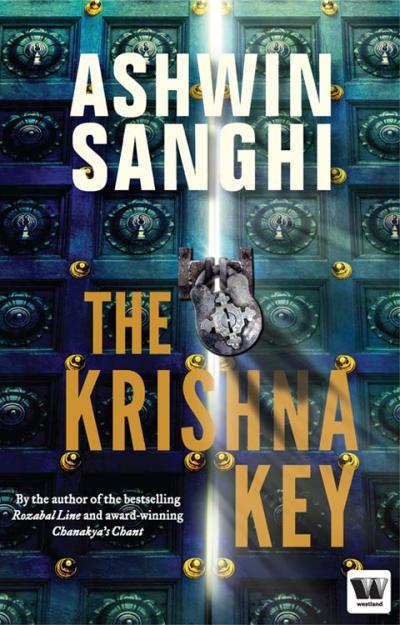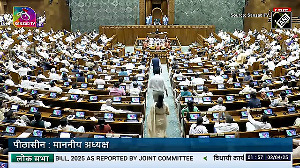 Accused of his childhood friend's murder, historian Ravi Mohan Saini must travel to discover one of Krishna's treasures and stop a serial killer who believes himself to be an avatar of the Lord.
Accused of his childhood friend's murder, historian Ravi Mohan Saini must travel to discover one of Krishna's treasures and stop a serial killer who believes himself to be an avatar of the Lord.
We bring you exclusive excerpts from bestselling author Ashwin Sanghi's latest book, The Krishna Key:
'You were wrong, Prof! It was two possible years -- 3067 BCE and 2183 BCE -- that remained as viable alternatives for the Mahabharata war according to Achar's research,' said Priya as they sat in Saini's office sipping sugary milk tea.
Priya was just shy of forty and her athletic lifestyle was evident from the perfect figure that she managed to maintain in spite of the occasional indulgences in sugary milk tea.
Daughter of a famous lawyer, Priya had disappointed her father when she elected history over law as her metier. Educated at St Xavier's College, Mumbai, she had proceeded to King's College, London, for an MA in history.
Returning to India, she had begun teaching before she tracked down Saini and persuaded him to accept her as a doctoral student so that she could develop a thesis on the historicity of Krishna and the events of the Mahabharata.
Quick-witted, beautiful, energetic and intelligent, Priya was precisely the sort of distraction that Saini did not need.
Saini's life was his work. He had loved someone once. He had even married her during his days at the University of Memphis.
Five years later, they had drifted apart when they realised that the only exciting part of their lives had been the novelty and freshness of the relationship. Marriage seemed to have ruined it all. The divorce had been quick and painless but it had forced Saini reengineer his life and move back to India.
'You are right Priya,' said Saini, 'but when one superimposes the information that Bhishma, the grand-uncle of both the Pandavas and the Kauravas, died in the month of Magha -- which occurs after the winter solstice -- the only remaining date is 3067 BCE. This emerges as a unique date for the Mahabharata war.'
'But simply arriving at a possible date for the Mahabharata war does not prove that it happened,' countered Priya. Priya had the habit of playing devil's advocate in order to analyse a point, even if she was in agreement with the hypothesis.
Saini was quick to rise to the challenge. 'Hence we must look outside the Mahabharata to see if any other sources can corroborate this date. Let's not rely on Indian sources and instead turn to Greek references, shall we?
Megasthenes, the Greek ambassador in the court of Chandragupta Maurya, made the first written reference to Krishna. In his account, Krishna is called Heracles. The Greeks renamed many Indian deities after their own, and the Greek usage of the name Heracles was influenced by the term Hari, the common expression used for Krishna.
Now what does Megasthenes tell us about Heracles? He writes that the Sourasenoi held Heracles in high esteem. Who are these Sourasenoi?'
'If I'm not mistaken, the Sourasenoi were actually the Shurasenas -- the Yadava descendants of Vasudeva's father, Shurasena. Krishna was a Yadava himself,' said Priya.
'Full marks to the backbencher,' joked Saini. He continued, 'Megasthenes goes on to describe their main city, Methora. Any guesses where Methora was?'
'Mathura!' exclaimed Priya.
'Precisely!' said Saini. 'Krishna is recorded by the Greeks as having lived a hundred and thirty-eight generations before the times of Alexander and Chandragupta Maurya. We may take the midpoint of Chandragupta's reign as 307 BCE.
Now, assuming twenty years per generation -- which is a fairly good average where ancient Indian dynasties are involved -- Krishna should have lived 2,760 years before 307 BCE. Do the arithmetic! You'll end up with 3067 BCE, the very same date arrived at by Achar's astronomical observations!'
Priya had a twinkle in her eyes. 'You're preaching to the choir, Professor. I was just testing you,' she said smiling.
Not quite convinced of her sincerity, Saini emphatically drove his point further. 'Just for some fun, let's also look at a third source, shall we?' he asked. 'The Surya Siddhantha is an ancient work on astronomy that provides the foundation for all Hindu and Buddhist calendars. This particular treatise tells us that at precisely midnight on 18 February in 3102 BCE, Kaliyuga began.
As you know, Kaliyuga is the last of the four stages that the world goes through as part of the cycle of Yugas described in the Indian scriptures, the three previous ages being Satyayuga, Tretayuga and Dvaparayuga. Hindus believe that human civilisation degenerates spiritually during the Kaliyuga -- almost a Dark Age -- because people get distanced from God.'
'How does the beginning of Kaliyuga tell us anything about the date of the Mahabharata war?' asked Priya mischievously, half-aware of the answer.
Saini considered the question carefully before choosing his words. 'According to Hindu philosophy, the very first event to distance us from God was the death of Krishna. Krishna was an avatar of Vishnu and his passing away symbolically marked the dawn of Kaliyuga. If we believe the Surya Siddhanta, the Mahabharata war took place around 3067 BCE, not 2183 BCE.'











 © 2025
© 2025